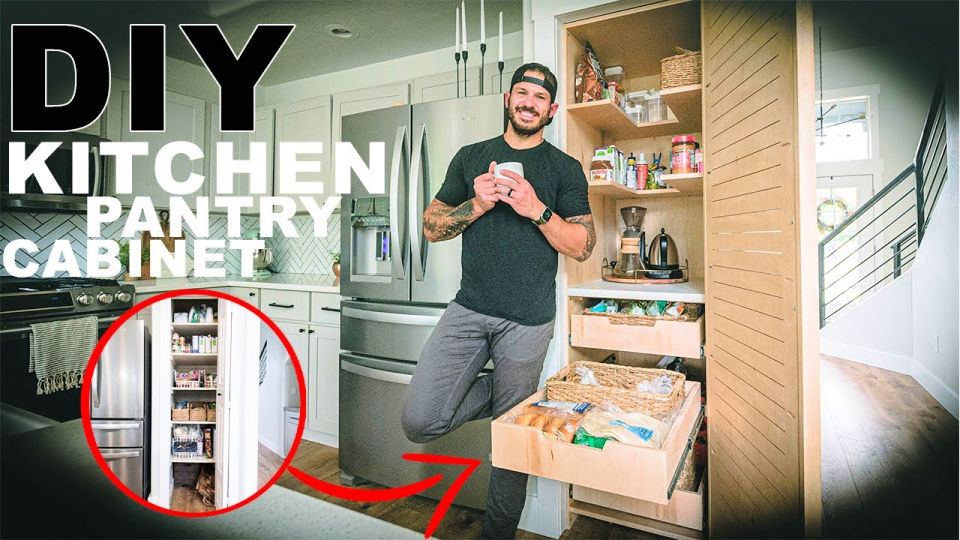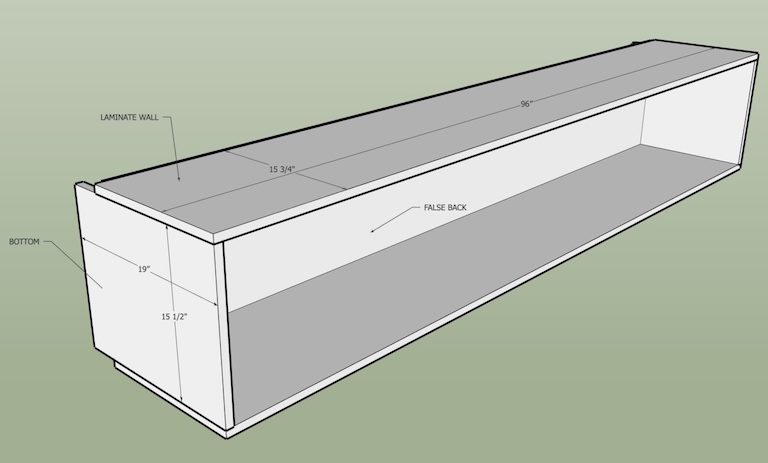Planning Your Built-In Pantry Cabinet: Built In Pantry Cabinet Plans

A built-in pantry cabinet is a fantastic way to maximize storage space in your kitchen and create a more organized and efficient cooking environment. It offers numerous advantages over traditional freestanding cabinets, making it a worthwhile investment for any homeowner looking to enhance their kitchen’s functionality.
Types of Built-In Pantry Cabinets
There are several types of built-in pantry cabinets, each with its own unique features and benefits. These types offer different storage solutions and configurations, allowing you to choose the perfect fit for your kitchen and storage needs.
- Walk-in pantries: Walk-in pantries are spacious, enclosed storage areas that provide ample room for storing a wide variety of items. They often feature shelves, drawers, and even countertop space for prepping food. Walk-in pantries are ideal for larger kitchens and offer a luxurious storage experience.
- Pull-out shelves: Pull-out shelves are a convenient and space-saving option for built-in pantries. They allow you to easily access items stored in the back of the cabinet, eliminating the need to dig through clutter. Pull-out shelves are perfect for storing frequently used items, such as spices, canned goods, and baking supplies.
- Sliding doors: Sliding doors are a great option for built-in pantries in smaller kitchens or where space is limited. They save space compared to traditional hinged doors and provide easy access to the pantry contents. Sliding doors can be made from various materials, including glass, wood, or metal, allowing you to match the style of your kitchen.
Measuring and Planning the Space
Before starting construction, carefully measure the available space for your built-in pantry cabinet. This will ensure that the cabinet fits perfectly and maximizes the available storage area.
- Determine the dimensions: Measure the width, depth, and height of the space where you want to install the pantry cabinet. Consider any existing features, such as windows or electrical outlets, that may affect the size of the cabinet.
- Consider the layout: Plan the layout of the shelves, drawers, and other storage features inside the pantry cabinet. This will help you maximize storage space and ensure that all your items have a designated spot.
- Choose the right materials: Select materials that are durable, moisture-resistant, and aesthetically pleasing. Common materials for built-in pantry cabinets include plywood, melamine, and solid wood.
Maximizing Storage Space
A well-designed built-in pantry cabinet can make a significant difference in how much you can store. Implementing a few smart strategies can help you maximize the storage space in your pantry cabinet.
- Use vertical space: Utilize the vertical space in the pantry cabinet by installing shelves that reach the ceiling. This will maximize storage capacity and prevent wasted space.
- Install pull-out drawers: Pull-out drawers are a great way to store smaller items, such as spices, snacks, and baking supplies. They make it easy to access items without having to rummage through shelves.
- Use tiered shelves: Tiered shelves create additional storage space within the pantry cabinet, allowing you to store more items in a smaller footprint. They are particularly useful for storing items of different heights, such as canned goods and jars.
- Add dividers: Dividers can help to organize shelves and keep items from sliding around. They are especially useful for storing plates, bowls, and other flatware.
Design Considerations for Built-In Pantry Cabinets

Designing a built-in pantry cabinet involves careful consideration of various factors to ensure functionality, aesthetics, and optimal storage solutions. The design process requires thoughtful planning, incorporating elements that cater to your specific needs and preferences.
Design Styles for Built-In Pantry Cabinets
The style of your built-in pantry cabinet should complement the overall design of your kitchen. Here are some common design styles to consider:
- Traditional: This style features classic details like raised panel doors, decorative moldings, and a warm color palette. It often uses wood finishes like cherry, maple, or oak.
- Modern: Modern pantry cabinets are characterized by clean lines, sleek surfaces, and minimal ornamentation. They often use materials like stainless steel, glass, or high-gloss finishes.
- Contemporary: Contemporary design emphasizes functionality and simplicity. It often incorporates open shelving, minimalist hardware, and a neutral color palette.
- Rustic: Rustic pantry cabinets feature natural wood finishes, distressed surfaces, and exposed hardware. They often use reclaimed wood or materials with a weathered look.
Materials and Finishes for Built-In Pantry Cabinets
The materials and finishes used for your built-in pantry cabinet will affect its durability, aesthetics, and overall cost. Here are some common options:
- Wood: Wood is a popular choice for pantry cabinets due to its durability, warmth, and versatility. Common wood species include oak, maple, cherry, and pine. Wood finishes can range from natural stains to painted surfaces.
- Laminate: Laminate is a durable and affordable option that offers a wide range of colors and patterns. It is resistant to scratches, stains, and moisture, making it suitable for high-traffic areas.
- Melamine: Melamine is a type of laminate that is known for its durability and resistance to scratches and stains. It is often used for cabinet boxes and shelves.
- Metal: Metal, such as stainless steel or aluminum, can be used for pantry cabinet doors and shelves. It is durable, easy to clean, and adds a modern touch.
- Glass: Glass can be incorporated into pantry cabinet doors or shelves to create a sleek and modern look. It allows you to see the contents inside, making it easier to find what you need.
Layout Design for Built-In Pantry Cabinets, Built in pantry cabinet plans
The layout of your built-in pantry cabinet should be designed to maximize storage space and optimize accessibility. Consider these features:
- Shelves: Shelves are essential for storing pantry staples, canned goods, and other items. Adjustable shelves allow you to customize the height to accommodate different sized items.
- Drawers: Drawers are useful for storing smaller items, like spices, baking supplies, and snacks. They can be organized with dividers or trays to keep items separated.
- Pull-out baskets: Pull-out baskets are great for storing heavier items, such as potatoes, onions, or fruits. They make it easy to access and retrieve items without having to reach into the back of the cabinet.
- Spice racks: Spice racks can be mounted on the inside of the pantry cabinet door or on a pull-out shelf to keep spices organized and easily accessible.
- Wine racks: If you enjoy wine, consider incorporating a wine rack into your pantry cabinet. It can be a dedicated section or integrated into the shelves.
Accessibility and Ergonomics in Built-In Pantry Cabinet Design
Accessibility and ergonomics are crucial for a user-friendly pantry cabinet. Consider these factors:
- Height: Ensure the shelves and drawers are positioned at a comfortable height for easy access. Adjustable shelves allow you to customize the height to suit your needs.
- Depth: The depth of the shelves and drawers should be appropriate for the items you plan to store. Avoid shelves that are too deep, as it can be difficult to reach items in the back.
- Lighting: Adequate lighting is essential for visibility inside the pantry cabinet. Consider adding under-cabinet lighting or a dedicated light fixture.
- Ventilation: Ensure proper ventilation to prevent moisture buildup and mold growth. This can be achieved through strategically placed vents or by leaving a small gap between the cabinet and the wall.
Construction and Installation of Built-In Pantry Cabinets

Building a built-in pantry cabinet can be a rewarding DIY project that adds valuable storage space to your kitchen. This section will guide you through the construction and installation process, providing step-by-step instructions and helpful tips for success.
Materials and Tools
Having the right materials and tools is essential for a smooth construction and installation process. Here’s a list of essential items you’ll need:
- Materials:
- Plywood or MDF for cabinet construction
- Cabinet doors and hardware (hinges, handles)
- Shelving material (wood, metal, or wire)
- Wood glue
- Screws, nails, and staples
- Paint or stain (optional)
- Caulk
- Primer
- Tools:
- Tape measure
- Level
- Circular saw or table saw
- Jig saw
- Drill
- Screwdriver
- Hammer
- Safety glasses and gloves
- Clamps
- Sandpaper
- Router (optional)
Building the Cabinet
Constructing the cabinet is the first step in creating your built-in pantry. This involves cutting and assembling the cabinet components, ensuring precise measurements and sturdy construction.
- Measure and Cut: Begin by measuring the space where your pantry cabinet will be installed. Transfer these measurements to your chosen plywood or MDF sheets and use a circular saw or table saw to cut the pieces for the cabinet sides, top, bottom, and shelves. Ensure all cuts are accurate and square.
- Assemble the Cabinet Frame: Apply wood glue to the edges of the cabinet sides, top, and bottom pieces. Secure them together using screws or nails, ensuring the corners are square and the frame is sturdy. Clamp the pieces together until the glue dries completely.
- Install Shelves: Once the cabinet frame is assembled, install the shelves. Cut the shelves to the desired length and width, then attach them to the cabinet sides using screws or shelf supports. Ensure the shelves are level and evenly spaced.
- Add Doors and Hardware: After the shelves are installed, attach the cabinet doors. Cut the doors to size and install the hinges, ensuring they open and close smoothly. Install the door handles or knobs for a finished look.
- Sand and Finish: Once the cabinet is assembled, sand all surfaces smooth. You can then paint or stain the cabinet to match your kitchen décor. Apply a primer before painting to ensure a smooth and even finish.
Installing the Cabinet
After the cabinet is built, it’s time to install it in the designated space. Proper installation ensures a secure and level fit, allowing for easy access to your pantry.
- Prepare the Wall: Ensure the wall where the cabinet will be installed is clean and free of any obstacles. If necessary, use a stud finder to locate the wall studs for support.
- Attach the Cabinet: Position the cabinet against the wall and use a level to ensure it is plumb and level. Secure the cabinet to the wall studs using screws or anchors. If the cabinet is freestanding, you may need to attach it to the floor or countertop for stability.
- Finish the Installation: After the cabinet is secured, caulk any gaps between the cabinet and the wall to create a smooth and finished look. Apply a bead of caulk along the edges and smooth it with a damp finger or a caulk tool. Once the caulk is dry, you can paint or stain it to match the cabinet.
Built in pantry cabinet plans – Planning a built-in pantry cabinet? It’s a great way to add storage and style to your kitchen! But remember, keeping those beautiful wood cabinets looking their best requires some TLC. Check out this awesome guide on wood cabinet cleaner and polish to keep your pantry cabinets shining for years to come.
And once you’ve got that down, you’ll be ready to stock your pantry with all the delicious things you need for your next Balinese feast!
Planning your built-in pantry cabinets? Don’t forget to think about those awkward spaces! A 12 inch wide cabinet with drawers can be a lifesaver for storing spices, oils, or even small appliances. It’s all about maximizing every inch of space, right?
Once you’ve got those narrow spots sorted, you’ll be on your way to a beautifully organized pantry.
